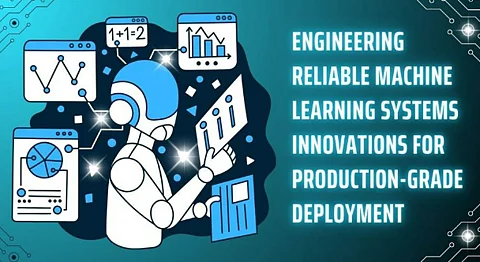

In the rapidly evolving field of artificial intelligence, Aditya Singh, a research engineer in the domain of machine learning systems, discusses a disciplined approach to establishing dependable, highly scalable, and efficient ML infrastructure in the burgeoning domain of AI. His specific contribution is developing methods to better deal with production-deployment needs, where all models are always experimental, providing high system dependability, easy maintainability after several years of development, and ease of alignment with the continuous changing landscape in the deployment of AI. By addressing critical gaps in scalability, resource efficiency, and fault tolerance, it ensures that production systems meet real-world demands.
Machine learning systems in production operate under fundamentally different constraints compared to experimental environments, demanding more stringent performance and reliability standards. Experimental models prioritize accuracy, while production systems must handle unpredictable workloads, maintain consistent performance, and integrate seamlessly with existing infrastructure. This transition introduces challenges like managing feature drift, optimizing computational efficiency, and maintaining reliability under dynamic conditions. The framework addresses these challenges, offering practical solutions that ensure a smooth transition from experimentation to large-scale operational environments.
One of the primary components of production-grade ML systems is thorough monitoring and real-time observability, which are crucial to ensuring reliability. A multi-layered observability strategy tracks model-specific metrics, for example, on prediction accuracy and confidence scores or system-level indicators such as resource utilization, latency, or throughput. Structured logging frameworks and intelligent alert mechanisms allow proactive issue detection, real-time anomaly detection, and long-term trend analysis. This will ensure that the production systems maintain the required high levels of availability and performance with minimum costly downtime and errors.
It's actually the reliable pipelines of feature engineering that create a backbone in producing high-quality data for the purpose of both training and inference. Production-focused designs are then aimed at bettering computational efficiency and scalability under varied workloads. Some significant innovations include how these pipelines cut data latency via advanced caching, how they build validation frameworks checking on data integrity, and other related features in which these are developed to handle big-scale and real-world applications in ML efficiently.
Machine learning models require sophisticated strategies when deployed in production environments to avoid risks and ensure system stability in case of updates or changes. Techniques such as canary and shadow deployments enable the gradual testing of new models in real-world environments without disturbing existing operations. Canary deployments route a small percentage of traffic to new models, enabling teams to monitor real-time performance, scalability, and reliability. Shadow deployments process production data in parallel with existing models, thereby allowing for extensive comparisons of the accuracy of prediction, latency, and resource usage before full-scale deployment.
Maintaining performance and reliability in production environments demands efficient resource management strategies to optimize utilization and prevent failures under heavy workloads. Strategies like circuit breakers, intelligent caching, and graceful degradation mechanisms handle dependency failures, performance degradation, and sudden workload spikes. Distributed processing frameworks further optimize resource allocation, ensuring scalability and fault tolerance even in high-demand conditions. These approaches provide ML systems with the resilience and adaptability required for dynamic and unpredictable environments.
However, these advances also pose new challenges to production ML systems in terms of integration with legacy infrastructures, managing system complexity, and ensuring compatibility across diverse platforms. Some of the future research areas include automating the decision-making process for deployment, optimizing resource allocation for hybrid architectures, and sustainability concerns through energy-efficient computing practices. These challenges underscore the need for continuous innovation to meet the evolving demands of production-grade ML infrastructure and adapt to industry trends.
Adoption of cutting-edge distributed computing frameworks, hybrid architectures, and the most recent multi-accelerator systems holds the key for efficient scaling up to future production-grade ML systems. Development of systems capable of dynamic conditions like data drift, workload variation, and shifting regulatory requirements will play a vital role. Research on techniques like mixed-precision training, hardware-aware optimization, and automated resource allocation will help bring out systems more efficiently, more adaptable, and more scalable so that the entire thing works toward long-term sustainability.
In conclusion, Aditya Singh lays out a complete groundwork for robust, scalable, machine learning system designs. Monitoring critical aspects, along with feature engineering, deployment strategy, and management of resources-all of this contributes to production-grade ML infrastructure which becomes a benchmark. Such inventions make sure the AI system doesn't lag back, remaining trustworthy, efficient, and ready to be built. As the field evolves, his framework will continue to guide the development of next-generation ML systems, ensuring their success in increasingly complex operational environments.
This version ensures that the first and last names are used only in the introduction and conclusion, as requested. Let me know if further revisions are needed!
